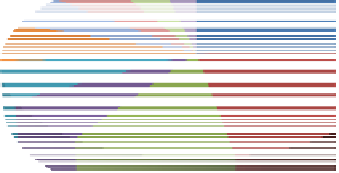Information Technology Reference
In-Depth Information
DĞĚŝĐŝŶĞ
KŶĐŽůŽŐLJ
^ƚƌĞƐƐŵĞĚŝĐŝŶĞ
dƌĂŶƐƉůĂŶƚĂƚŝŽŶ
ŝĂďĞƚŽůŽŐLJ
&ƵŶŐŝ
ƌĞĂƐƚĐĂŶĐĞƌ
EĞƉŚƌŽůŽŐLJ
Fig. 8.
CBR Health Sciences domains
describe diagnoses, 18 papers describe classification tasks, and 11 papers are
survey papers. Image interpretation also accounts for 9 papers, and research
support for 6 papers.
Memory.
Memory structures and organization refers to 17 different concepts.
The most represented is prototypes (24 papers), closely followed by time series
(20 papers). Further come images (12 papers), text (6 papers), microarray data
(5 papers), clusters (3 papers), generalized cases (3), inverted indexes (2 papers),
networks (2 papers), and genomic sequences (2 papers). The other listed memory
structures are graphs, multimedia data, plans, structured cases, and visio-spatial
cases.
Reasoning.
Surprisingly, for a methodology like CBR where research is very
active in all reasoning cycle phases, in CBR in the Health Sciences the vast
majority of systems refer to retrieval only (61 papers). Maintenance is also well
represented (11 papers), and adaptation (8 papers). Further are represented:
indexing (3 papers), retain (3 papers), similarity measures (2 papers), and revi-
sion (2 papers). However many systems also perform additional reasoning steps,
even though the papers studied did not detail these steps, focusing on retrieval
aspects instead.
System design.
The main characteristics of developed systems include tem-
poral abstraction (22 papers), knowledge-based systems combination (18 pa-
pers), prototype and generalized case mining (10 papers), temporal reasoning
(7 papers), fuzzy logic (6 papers), information retrieval combination (6 pa-
pers), knowledge acquisition combination (5 papers), and in 3 papers: clinical





















































































































































































































































































































































































































































































































































































































































































































































































































Search WWH ::

Custom Search